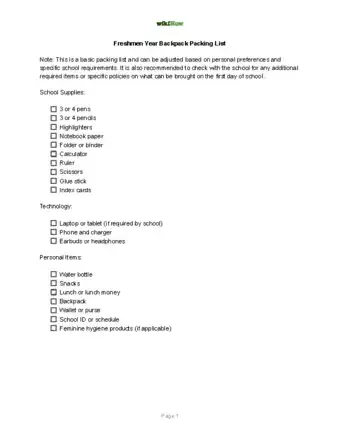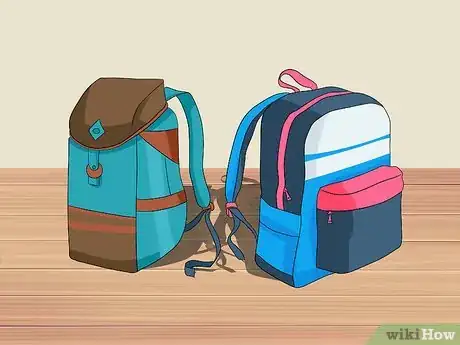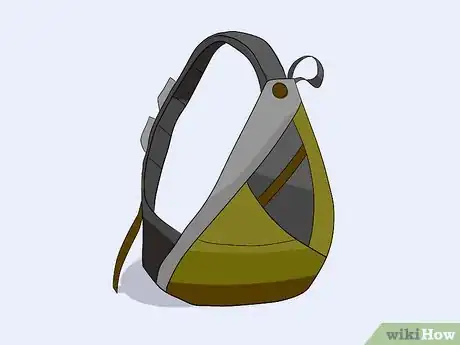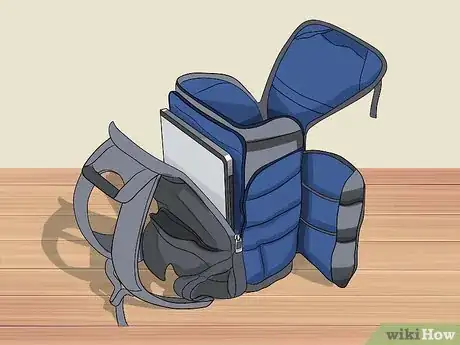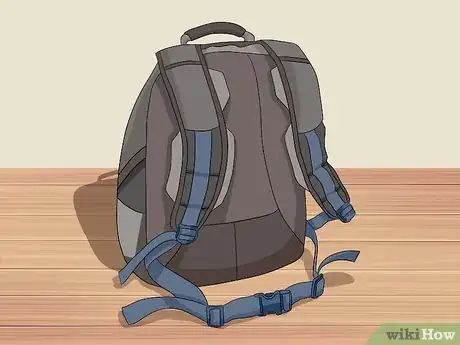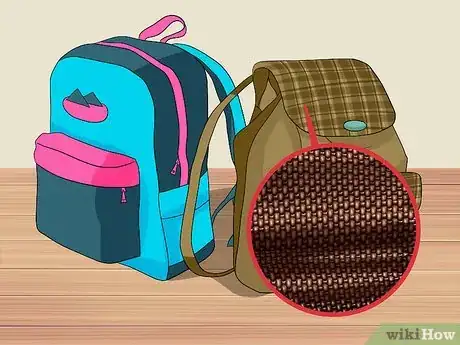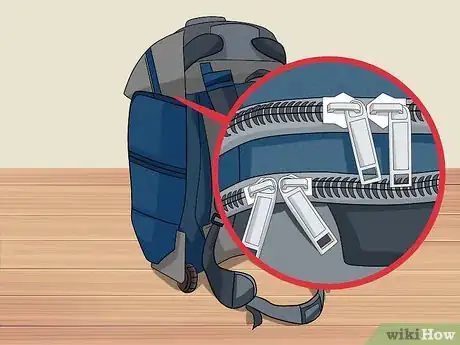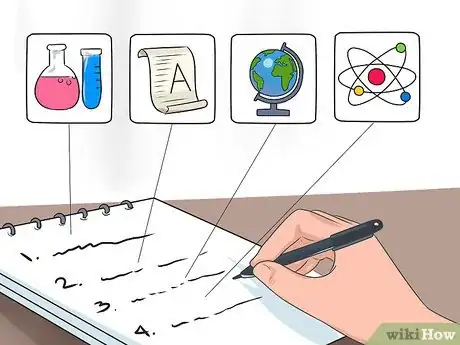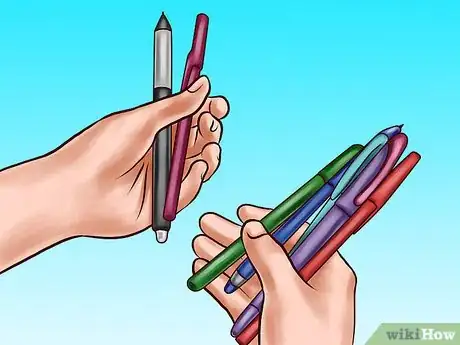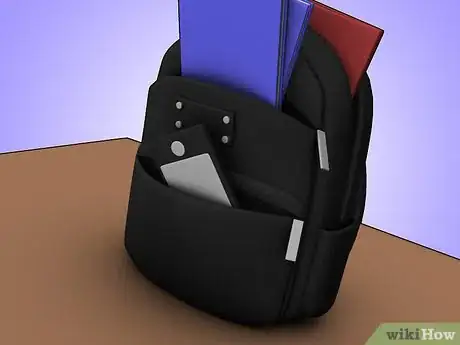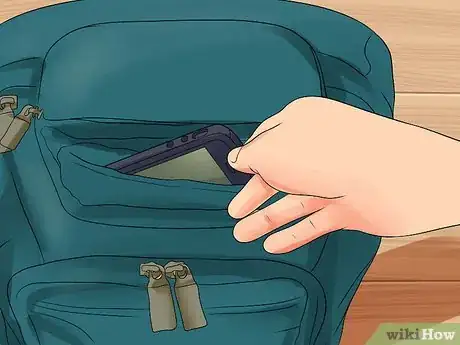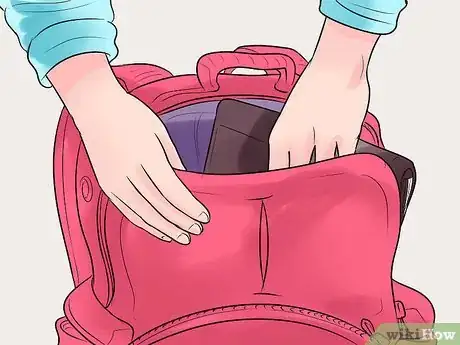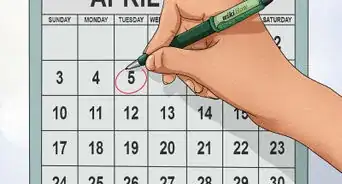This article was co-authored by Ashley Pritchard, MA. Ashley Pritchard is an Academic and School Counselor at Delaware Valley Regional High School in Frenchtown, New Jersey. Ashley has over 3 years of high school, college, and career counseling experience. She has an MA in School Counseling with a specialization in Mental Health from Caldwell University and is certified as an Independent Education Consultant through the University of California, Irvine.
This article has been viewed 47,488 times.
Your first day as a Freshman in high school can be both stressful and exciting, especially when you're worrying about first impressions and meeting friends. Fortunately, how to pack your bag doesn't have to be another cause for alarm thanks to the practical wisdom gathered from decades of Freshman, first-day experiences. So, even if you're feeling like a nervous mess, at least your backpack will be organized and ready!
Steps
Freshmen Year Backpack Packing List
Purchasing a Backpack
-
1Think long-term investment. Ideally, you'll want this backpack to last you all four years, so investing in a good one is a smart decision. Expect to spend upwards of $50 for a good backpack.
-
2Choose a backpack type. There are many different types of backpacks that offer advantages and disadvantages in style and utility. Try out a few in a store and see which feels best to wear and access.[1]
- Top-loaded bags come in either zipper or strap closure: the former offers more security; the latter usually offers a bit more room for items.
- Messenger bags are popular and stylish with a single strap. The disadvantages are that they become bulky and awkward to wear when they're full and that the weight is unevenly distributed on your shoulders, which is not good for your back.
- Wheeled bags are great for transporting heavy books; however, even when empty, they are heavier than other bags because of their wheels, so make sure you're able to lift it without straining your back. Forewarning: a wheeled backpack will not fit in your locker, and some schools do not allow wheeled backpacks, so check to make sure.
- Classic, full-zipper bags offer easy access to your contents and are the most versatile for school use.
Advertisement -
3Choose a backpack size. When considering size, think not only about how many school books you're willing to carry on your back, but also about the size of your body: if it's too big/small it won't fit correctly.
- Most backpack companies provide an online size chart, but you should try on several backpacks to see what size fits your unique body.
- It's not advisable to carry more than 15% of your body weight on your back, so keep this in mind when looking at backpack sizes and imagining how much you'll be packing.[2]
-
4Decide on compartments. How many compartments you use depends on your style of organization. Consider the following questions when deciding:[3]
- What do you intend to pack in your backpack and what do you intend to carry? Big books? Your lunch? A water bottle?
- Do you intend to pack your laptop in your backpack? If so, look for bags with a laptop compartment, which usually provides added cushioning.
- Do you want built-in compartments for your pens/cellphone/MP3 player/sunglasses?
-
5Consider ergonomics. Ergonomics has to do with efficient harmony between your body and your work environment, and in terms of backpacks it means back safety. Here are some ergonomic features to consider:[4]
- Wide, padded shoulder straps. Relieves strain on your shoulders. Moreover, make sure the straps are adjustable.
- (Breathable) Back padding. Relieves pressure on your lower back.
- Hip padding. Helps balance the backpack and take some pressure off your back by distributing it to your hips.
- Chest and/or hip belt. Relieves pressure from your lower back and helps you to stand up straight.
-
6Choose a fabric. A backpack's fabric will determine its weight, breathability, and durability. Moreover, some fabrics offer limited style with great weather protection, but others offer style with limited weather protection -- so you may have to compromise.
- Synthetic fabrics, such as polyester and nylon, are lightweight and waterproof fabric, so they will hold up best against the elements.
- Natural fibers, such as hemp, are more environmentally sustainable, but do not offer much protection against the elements.[5]
- Leather gains "character" as it ages, but is heavier and less flexible.
-
7Consider the zippers. Heavy duty, double-headed zippers are the best because they are sturdy and offer easy-access to your contents.
Purchasing Your First Day's Supplies
-
1Examine your first day's schedule. How your day looks as far as types of classes and extra-curricular activities will dictate what you will need to pack.[6] Ask yourself the following questions:
- How many/What kind of classes do you have?
- Do you have gym today?
- Will you be staying late for a club and/or sports activity after school?
-
2Purchase notebooks or a binder. You have several options when it comes to your paper, and your decision is ultimately personal preference unless your teacher requests one in particular.
- Binder. The binder option is good because you can divide it into sections and easily add and remove paper. Moreover, the binder protects the edges of the pages and sometimes even has a built-in folder. The drawbacks of the binder are that it can be bulky and space-consuming, the binder rings sometimes rips through your paper, and it can be awkward to write in if you're left-handed.
- Notebooks. The notebook option offers flexibility with 1-, 3-, or 5-subject spiral-bound or composition notebooks, so you have the ability to consolidate your backpack space. At the very least, though, you'll want a separate section/notebook for each class's notes.
- Paper type. Teacher preferences vary, however, most high school teachers do not care if you take notes or submit written assignments on wide or college ruled paper. If you have the means, when buying loose leaf paper consider paper with reinforced holes to avoid accidental tears.
-
3Purchase a day planner. Writing your assignments and other miscellaneous notes in a day planner will relieve you of trying to keep all that miscellaneous information in your head. If your school allows, consider a digital planner. Many sync online so one can cross-off assignments on any digital device.
-
4Purchase pens. These are easily lost or broken, so pack extra (at least three).
- Black or blue ink is the safest investment because some teachers don't allow you to use colored gel pens on tests.
-
5Purchase whiteout. Crossing-out on tests or in your notebooks will make you look sloppy and disorganized, so having a whiteout handy is convenient.
- Look for a roll-out whiteout, as liquid whiteout can get messy and takes time to dry.
-
6Purchase pencils. Mechanical and wooden pencils each have their advantages and disadvantages, so consider the following:
- A mechanical pencil does not require sharpening, but you have to carry around lead refills.
- A mechanical pencil sometimes "jams," and the last bit of lead is difficult to use because it tends to slip out of the shaft.
- A wooden pencil requires sharpening (sometimes frequently), so you'll need to carry a sharpener or use your classroom's electrical sharpener.
- A wooden pencil is more difficult to keep sharp because the tip tends to break off with pressure.
- Regardless of which type of pencil you choose, purchase a separate eraser that erases cleanly because the erasers on most pencils tend to get streaky.
-
7Purchase 1-3 folders. One folder might be enough, but more may help you stay better organized between your different classes.
-
8Purchase a calculator (optional). Few classes hit the ground running, but you don't want to be unprepared, so, if you own one, bring your calculator just in case. If you don't own a calculator, ask your Math teacher after class which calculator he/she recommends.
- If you do purchase a calculator, make sure it is a graphing calculator.
Packing Your Backpack
-
1Pack tallest, largest, and heaviest items first. Your binder, folders, notebooks, and whatever textbooks you have should go against your back in your bag's main compartment.[7]
-
2Pack smaller, lighter objects last. Your day planner and your pen and pencil case (if applicable) should go toward the outside of your bag.
- If you have other compartments, sometimes there are places especially designed for these items, so utilize those to save space and to help distribute the weight evenly.[8]
- Gym clothes could be packed with these items, but it's better to use a separate, drawstring bag because gym clothes will make your bag smell unfavorably.
-
3Pack your breakables. These include your lunch, your water bottle, your calculator, and any other items that are liable to be damaged or crushed: these should go on top of the contents of your bag's main compartment or in its own, separate compartment.[9]
- Sometimes a backpack has a sleeve for your water bottle.
- If your lunch doesn't fit with extra room, it's better to carry it than risk having to eat bruised or smushed food. Alternatively, many schools have cafeterias, so you could always purchase your meal there.
- Often a backpack will have a compartment for your cellphone and headphones/earbuds.
-
4Double-check you've remembered everything. Have you remembered to pack all that you need? Here are a few questions to jog your memory:
- Do you need to pack athletic/spare clothes for gym or an extracurricular activity? If so, consider a drawstring bag for these.
- Did you pack a big enough lunch if you're staying late at school?
- Did you pack your important school papers, such as your class schedule, immunization form, or any miscellaneous permission forms?
- Do you want to bring a ball or frisbee for lunch or after school?
- What's the weather going to be like? Do you need to bring an umbrella or a rain jacket?
- Do you know what time your bus arrives at your stop? Do you have some extra money in case you need to call a cab?
Expert Q&A
-
QuestionWhat do you need on your first day of freshman year?
 Ashley Pritchard, MAAshley Pritchard is an Academic and School Counselor at Delaware Valley Regional High School in Frenchtown, New Jersey. Ashley has over 3 years of high school, college, and career counseling experience. She has an MA in School Counseling with a specialization in Mental Health from Caldwell University and is certified as an Independent Education Consultant through the University of California, Irvine.
Ashley Pritchard, MAAshley Pritchard is an Academic and School Counselor at Delaware Valley Regional High School in Frenchtown, New Jersey. Ashley has over 3 years of high school, college, and career counseling experience. She has an MA in School Counseling with a specialization in Mental Health from Caldwell University and is certified as an Independent Education Consultant through the University of California, Irvine.
School Counselor Your school should provide a supplies list. If they don't give you one of these, just bring a pen and a notebook. You can also bring personal items, like chapstick, hygiene items, and a phone charger. The first day of high school is typically filled with orientation activities and syllabus readings, so try not to overthink it.
Your school should provide a supplies list. If they don't give you one of these, just bring a pen and a notebook. You can also bring personal items, like chapstick, hygiene items, and a phone charger. The first day of high school is typically filled with orientation activities and syllabus readings, so try not to overthink it.
Things You'll Need
- Class schedule
- Pens and pencils
- Whiteout
- Notebook(s)/Binder
- Folder(s)
- Day planner
- Calculator (optional)
- Gym clothes (if applicable)
References
- ↑ https://kidshealth.org/en/teens/backpack.html
- ↑ https://health.clevelandclinic.org/7-tips-to-a-lighter-safer-school-backpack/
- ↑ https://kidshealth.org/en/teens/backpack.html
- ↑ https://www.nsc.org/community-safety/safety-topics/child-safety/backpack-safety-for-kids?
- ↑ http://www.parents.com/kids/education/elementary-school/choosing-the-best-backpacks-for-kids-/
- ↑ Ashley Pritchard, MA. Academic & School Counselor. Expert Interview. 4 November 2019.
- ↑ https://health.clevelandclinic.org/7-tips-to-a-lighter-safer-school-backpack/
- ↑ http://www.spine-health.com/wellness/ergonomics/tips-prevent-back-pain-kids-backpacks
- ↑ https://www.nsc.org/community-safety/safety-topics/child-safety/backpack-safety-for-kids?
- ↑ Ashley Pritchard, MA. Academic & School Counselor. Expert Interview. 4 November 2019.
